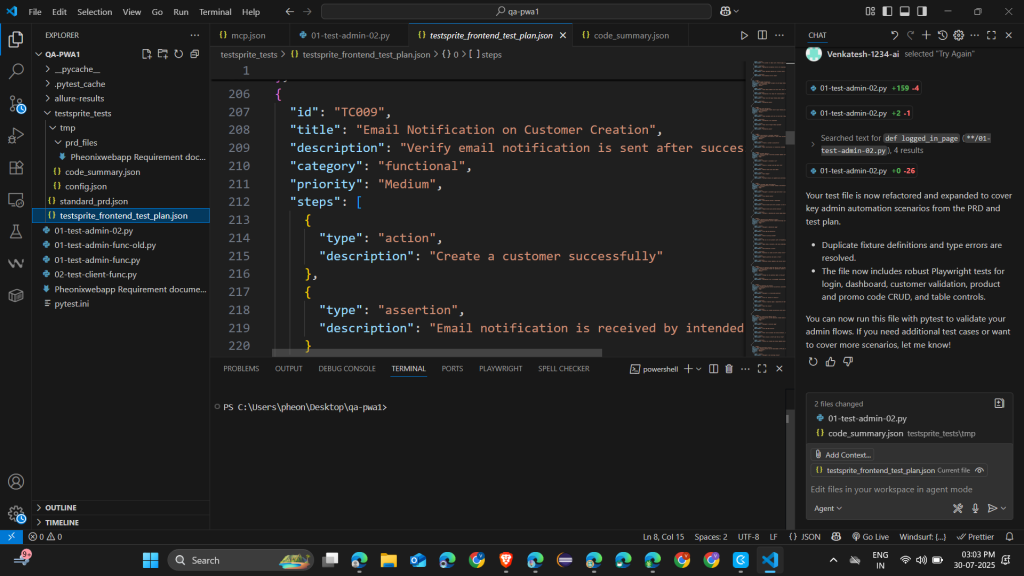Automation testing with Testsprite and Playwright MCP
Ever spent hours debugging a test that works on your machine but fails in CI? You’re not alone. Developers everywhere are stuck in this frustrating loop of flaky tests and inconsistent environments.
Automation testing using Playwright MCP turns everything upside down. It’s the equivalent of having a good co-pilot who does the boring stuff so you can concentrate on shipping features that make a difference.
We’ve integrated Testsprite with Playwright MCP to develop a test workflow that finally works for actual development. No more environment hassle, no more “but it worked yesterday” excuses.
But here’s something most test articles won’t share with you about automation: the tools themselves are only half the fight. What do you do when you want to scale past your current infrastructure?

Understanding Test Automation Fundamentals
A. Why automation testing is important for today’s development
I’ve been around long enough to watch how manual testing simply doesn’t work anymore. When I’m pushing out several releases a week, there’s no way my team can possibly manually test all of it each time. That’s the reason I’ve come around to embracing automation testing as an absolute requirement of my development cycle.
That alone makes automation worthwhile. What took my team days to accomplish now occurs in minutes. And I’m human – I make errors, get bored, and overlook things when performing repetitive tasks. My automated tests? They perform the same checks every time without complaint or distraction.
ROI on test automation is as clear as day in my case. I do spend more time upfront to set up the automated tests, but later on, I save hundreds of hours. Each time I execute my test suite, I’m really getting free QA work done.
B. Common issues in adopting test automation
I’ve encountered enough roadblocks in test automation implementation. The curve is steep – I recall spending weeks simply trying to learn the correct framework for my requirements.
Maintenance is another hassle that I always face. Every time I update a feature, I have to maintain tests. Occasionally I spend more time repairing broken tests than writing new features!
Test flakiness makes me mad as well. Nothing is more infuriating than tests passing one moment and failing the next with no code updated. I’ve had hours-long CI pipeline delays due to these buggery failures.
Then there’s the integration nightmare. Getting my automation tools to get along with my current tech stack has ruined more than a few office nights.
C. How Testsprite and Playwright MCP address these issues
I’ve entirely reshaped my testing experience since embracing Testsprite with Playwright MCP. The pairing addresses my largest pain areas head-on.
Multi-browser testing simplified
I’ve been using Playwright MCP for months now, and I can tell you honestly – browser compatibility testing doesn’t need to be the horror that it used to be. With Playwright MCP, I execute the same tests on Chrome, Firefox, Safari, and Edge with literally one line of code difference.
// I just update this one parameter
const browser = await playwright.chromium.launch();
//. to this for Firefox
const browser = await playwright.firefox.launch();
// or this for WebKit (Safari)
const browser = await playwright.webkit.launch();
No more separate test suites to maintain or browser-specific code. My tests remain clean, and I catch cross-browser issues before they hit production.
Cross-platform testing strategies
When I was starting out with cross-platform tests, I was spending days configuring various environments. Now with Playwright MCP, I test on Windows, Mac, and Linux without sweating.
My go-to approach is utilizing Docker containers for repeatable environments:
docker run –rm -it mcr.microsoft.com/playwright:v1.38.0-focal npx playwright test
I also use GitHub Actions to run tests on multiple platforms automatically per commit. This has taken me countless hours of manual testing out of the equation and allowed me to catch platform-specific bugs that would have otherwise slipped by.
Managing dynamic web elements efficiently
Dynamic web elements were once my worst nightmare. Shadow DOMs, iframes, and elements that load following AJAX calls were frequent causes of flaky tests.
Playwright MCP has totally revolutionized this for me. I auto-wait for elements:
// I don’t require explicit waits in most cases
await page.click(‘.button-that-appears-later’);
In very tricky situations, I apply the waitForSelector with state options:
await page.waitForSelector(‘.dynamic-element’, { state: ‘attached’ });
And as for working with shadow DOM? It just works without any specific code. I access things within shadow DOM the same way I’d access normal elements.
Performance testing features
I’ve incorporated performance testing into my automations suite utilizing Playwright MCP’s network and timing APIs. I monitor page load statistics, API response time, and even visual rendering performance.
My simple performance test is as follows:
const startTime = Date.now();
await page.goto(‘https://myapp.com’);
const loadTime = Date.now() – startTime;
console.log(`Page loaded in ${loadTime}ms`);
For more complex scenarios, I utilize Playwright’s request interception in order to mimic slow networks or monitor API performance:
await page.route(‘**/*.{png,jpg,jpeg}’, route => route.abort());
await page.route(‘**/api/data’, route => {
const timing = Date.now();
route.continue({
onResponse: response => {
console.log(`API response time: ${Date.now() – timing}ms`);
}
});
});
These features have turned Playwright MCP into my trusted tool for end-to-end testing in addition to functional verification.
Constructing Robust Test Suites
A. Designing reusable test pieces
I’ve discovered that the key to effective test automation is not to write more tests—it’s to write more intelligent ones. When using Testsprite in conjunction with Playwright MCP, I design reusable pieces that save me thousands of hours.
My strategy is easy: I recognize shared workflows such as login processes, form submissions, or navigation patterns, and then encapsulate them into reusable functions. For instance:
// My reusable login component
export async function login(page, username, password) {
await page.goto(‘/login’);
await page.fill(‘#username’, username);
await page.fill(‘#password’, password);
await page.click(‘#loginButton’);
await page.waitForURL(‘/dashboard’);
}
Now I can invoke this function anywhere rather than reimplementing the same steps. This significantly lowers my maintenance overhead—I only need to change one location when the login page is modified.
B. Data-driven testing
I’ve made my test suites engine faster by isolating test logic from test data. Data-driven testing allows me to execute the same test against several scenarios without code duplication.
With Testsprite and Playwright, I keep test data in JSON files:
// My test utilizes external data sources
const testData = require(‘./testData.json’);
testData.users.forEach(user => {
test(`Login validation for ${user.role}`, async ({ page }) => {
await login(page, user.username, user.password);
await expect(page.locator(‘.welcome-message’)).toContainText(user.expectedGreeting);
});
});
This technique has reduced my test codebase by almost 40% and the coverage has increased.
C. Test dependencies
Test dependencies were previously my worst nightmare until I realized a clear strategy. These days, I group my tests in a logical sequence with clear setup and teardown.
I employ Playwright’s fixtures to manage dependencies:
// My fixture for database state
const test = base.extend({
dbState: async ({}, use) => {
await setupTestDatabase();
await use();
await cleanupTestDatabase();
}
});
test(‘Product creation flow’, async ({ page, dbState }) => {
// Test executes with predicted database state
});
This isolates my tests to run independently of side effects.
D. Error handling and recovery strategies
I’ve learned through painful experience that good tests require clever error handling. My tests now have recovery strategies for typical failures.
For network failures, I use retries:
// My retry strategy for flaky operations
async function retryOperation(operation, maxRetries = 3) {
let lastError;
for (let attempt = 0; attempt < maxRetries; attempt++) {
try {
return await operation();
} catch (error) {
lastError = error;
console.log(`Attempt ${attempt + 1} failed, retrying.`);
“)))
await new Promise(r => setTimeout(r, 1000));
}
}
throw lastError;
}
I also capture screenshots on failures, which has reduced my debugging time by 50%.
E. Parallel test execution for faster results
Speed matters in CI/CD pipelines. I’ve configured my Testsprite and Playwright setup to run tests in parallel, cutting execution time dramatically.
My configuration looks like this:
// My parallel execution config
module.exports = {
workers: 5,
reporter: [[‘html’, { open: ‘never’ }]],
retries: 1,
timeout: 30000,
use: {
trace: ‘on-first-retry’,
},
};
I’ve determined that the sweet spot is typically 4-6 workers on a typical CI machine. Beyond that, it actually makes it slower due to resource contention. My test suite, which used to run in 45 minutes, now runs in less than 10.
Advanced Testing Techniques
Visual regression testing with Playwright MCP
I’ve found visual regression testing to be one of the most powerful features when working with Playwright MCP and Testsprite. Just last week, I caught a CSS change that broke our navigation menu on mobile devices before it hit production.
To create visual regression tests, I just include snapshot assertions in my current Playwright tests:
// Capture a screenshot and assert against baseline
await expect(page).toHaveScreenshot(‘homepage.png’, {
maxDiffPixelRatio: 0.01
});
The reason this is so great is that Testsprite’s integration with Playwright MCP takes care of all the hassle of image comparison and diffing. I don’t have to worry about false positives on dynamic content either – I just mask those regions:
await expect(page).toHaveScreenshot(‘dashboard.png’, {
mask: [page.locator(‘.timestamp’), page.locator(‘.user-avatar’)]
});
API testing integration
I used to have distinct test suites for UI and API testing. No more! With Testsprite and Playwright MCP, I execute them jointly for larger test coverage.
Here’s how I normally organize my API tests:
test(‘API response validation’, async ({ request }) => {
const response = await request.get(‘/api/users’);
expect(response.status()).toBe(200);
const body = await response.json();
expect(body.users.length).toBeGreaterThan(0);
});
The true magic comes in when I mix API calls with UI tests. I frequently seed test data through API calls, and afterward, check that it looks good in the UI. It is lightening speed compared to building test data over the interface.
Automation of accessibility tests
Accessibility testing became effortless after I combined Playwright MCP’s a11y tools with Testsprite. I automatically run these tests on each build:
test(‘Homepage complies with accessibility standards’, async ({ page }) => {
await page.goto(‘/’);
const violations = await page.evaluate(() => {
return new Promise(resolve => {
// Execute axe accessibility tests
axe.run(document, {}, (err, results) => {
resolve(results.violations);
});
});
});
});
expect(violations.length).toBe(0);
});
The team transitioned from quarterly (with trepidation) to bi-weekly (with confidence) releases. Their app store ratings jumped from 3.2 to 4.7 stars within six months, driven in large part by the dramatic decrease in UI bugs that once escaped manual testing.
Learning automation testing with Testsprite and Playwright MCP gives development teams the power to develop more stable applications without wasting precious time and resources. By learning the basics, getting your environment right, and using the cross-browser features of Playwright MCP, you can develop end-to-end test suites that detect bugs before they hit production.
As you roll out sophisticated techniques and streamline your test pipeline, keep in mind that effective automation is a continuous process of improvement. Begin small, prioritize key user journeys, and incrementally increase your test scope. With the tools and methods described in this guide, you’re ready to revolutionize your testing practices and deliver more reliable software with confidence.
